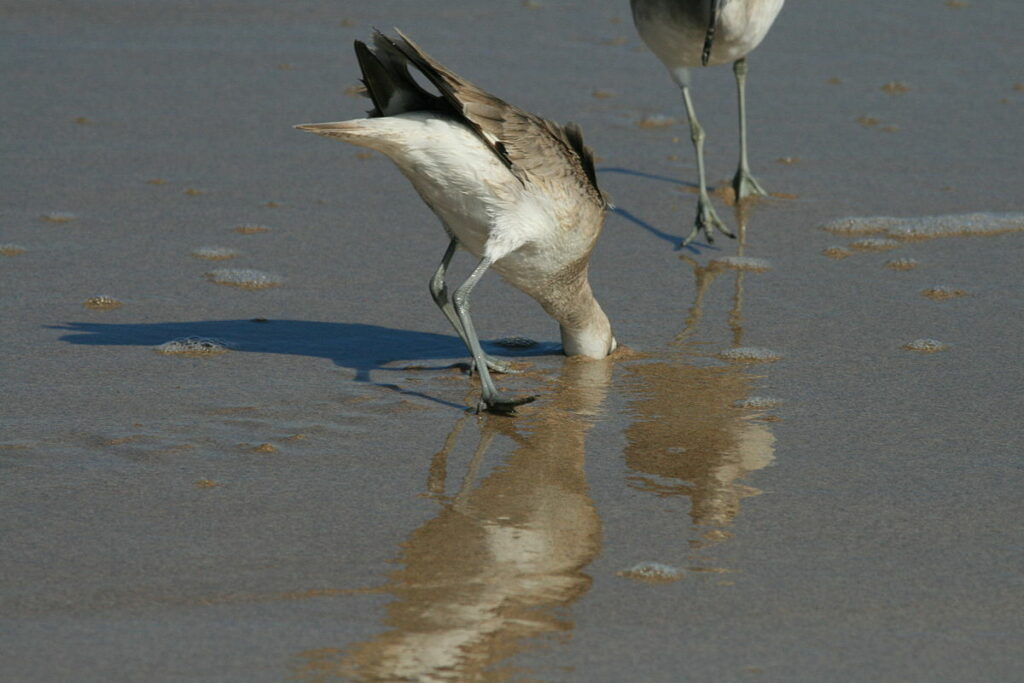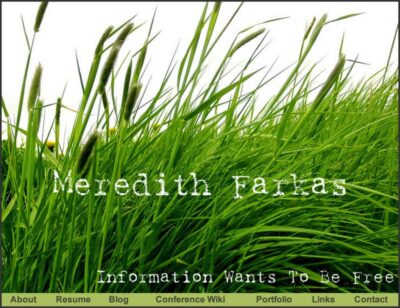Last Spring, while Chairing the library track of HigherEd BlogCon and feeling like it was not an engaging enough online conference model, I had a crazy idea to create a free online conference with more synchronous and asynchronous pieces to really draw people in and build a community. I refused to believe that the only way to have the great dialogues that you have between sessions at a physical conference was by going to a physical conference. Then the ALA 2.0 Bootcamp happened and I saw how close ALA came to creating a truly great online learning opportunity and yet how they really missed the mark with it. I remember Kathleen Gilroy’s comment “the larger lesson here is that if you think you can just throw together a few pieces of technology and get things to work differently you are deluding yourselves.” When I saw that, I immediately decided that I wanted to create an online course using as many open source tools as possible and it was going to be free and it was going to be something really special. I wasn’t quite sure how, but I wanted to show that it was possible.
My response to Ms. Gilroy’s comment was this:
Jinkies! If that doesn’t sound like a challenge, I don’t know what does! I don’t know what she means by “throw together a few pieces of technology” but yes, I think I can do it better (with a little help from my friends). At least I’d like to try… I just want to show that it can be done from the bottom up. Then people would realize how easily we can directly improve the profession without having to be a member of a professional organization (not that there’s anything wrong with that, but there are other ways to serve).
I was a little scared when I wrote my post last May, sort of picking up the gauntlet to create Five Weeks to a Social Library. I didn’t really know for sure if I’d be able to pull it off. With the help of my very excellent co-organizers – Michelle Boule, Dorothea Salo, Amanda Etches-Johnson (a brand-new mover and shaker!), Karen Coombs and Ellyssa Kroski – and the contributions of many, many, many other people (presenters, technical helpers, etc.), we created this amazing online learning experience that benefited not only the 40 people who took part in the course, but the many others who have benefited from the archived content. Moreover, we proved that this learning model can provide high-quality, collaborative, interactive online learning at bargain basement prices.
I think the best thing about the model is that there are so many different types of learning experiences. Each week, the participants watched screencasts, listened to podcasts, looked at concrete examples of the technologies, engaged with the technologies and perhaps read the optional readings. In addition to those solitary endeavors, they attended live Webcasts and had the opportunity to ask questions. They took part in weekly small group chats with between three and five other classmates and one of the organizers. For each of those screencasts and podcasts they watched alone, they had the opportunity to spend an hour with each presenter via our chatroom where they could ask questions and engage in conversations. And finally, they blogged, each week writing about their impressions of the technologies they were working with and whether or not they saw any use for them in their own library. This blogging and commenting on each other’s blogs created a whole additional level of dialogue. With all of these different synchronous and asynchronous, interactive and static, solitary and group learning experiences, the participants really were brought together in a way that I’ve never seen before in online learning. It was a lot of work, but the comments from our participants show that it led to much more meaningful interactions. While the material and the technologies were obviously valuable, I think it was the interactions with others that really gave participants the most valuable food for thought.
I am extremely happy to see that this course was such an amazing success and that the people who took part are already implementing social software in their libraries as a result. Incredible!!! What would make me even happier is to see other people, libraries, and organizations replicating this model. As I wrote last year, I wanted to show that this was possible so that other people could make this happen as well. Yes, it was a lot of work, but it was completely worth it. What a pleasure it is to know that you really had a positive impact on people’s professional lives. More than a talk, more than an all-day workshop. And you can do it too.
Today I got an e-mail from someone involved in ACRL who was interested in how I thought this model could be replicated. There is nothing magical about a lot of the decisions we made regarding the course. It doesn’t have to be five weeks’ long. I wanted it to be six to cover IM, podcasting and videocasting. Dorothea thought anything more than four was too long. We met in the middle. The course covered social software because that’s my primary interest. You could use the exact same model and offer a course on information literacy; assessment; scholarly publishing, copyright and open access; services for teens; programming for adults; designing for user experience; next generation reference work; collection development; etc. It could be three, four, five, six, or ten weeks long, depending on the subject matter and how much time you want people to devote to the course each week (though I think people might get burnt out with an 8 or 10 week class). I think what we packed into five weeks was probably the maximum that you could pack in without causing riots. And it would be too much for a lot of people. We picked 40 participants, but we could have had 30 or 80. It just depends on how many facilitators you have in the course. Our small groups for the chats were supposed to be five participants and one organizer/facilitator, though some of our groups ended up being smaller or a bit larger due to scheduling issues. I think five participants and a facilitator is the perfect number for a group discussion, so the more facilitators you have, the more participants you can have while still making the discussions meaningful. Though you can have too many participants, where the number of blog posts each week becomes impossible for people to keep up with. I think we found the sweet spot, but there is definitely a range at which things would still work out quite well.
Do you have to offer as many asynchronous screencasts and podcasts as we did? Probably not. Probably offering two live Webcasts each week would be enough for certain subjects. But don’t give up those Webcasts because that was one of the things the participants loved the most. They wrote that it’s where they really felt part of a community and where they found so many of the ideas they had for implementing these tools in their library. That interaction was so valuable, as any of our participants or live presenters would attest. If you do offer asynchronous presentations, ask those presenters to make themselves available in a chatroom for an hour the week their presentation is offered. I wasn’t sure if people would take advantage of the opportunity to chat with the presenters, but many people did and it was cited in participants’ comments as something they really found meaningful.
Just remember, everything we did for this program is licensed under a Creative Commons Attribution-Non-Commercial-Share-Alike license, which means that you can use any of the course concept or content (all of the presentations, folks!) in a course of your own and can adapt the model to your own needs. But you can’t take the concept and/or content and use it in order to make money. And you can’t take the concept and/or content, modify it and avoid licensing it under the same terms. Other than that, go crazy! Just let me know if you’re using anything from the course in a program of your own so that I can post it to the Five Weeks to a Social Library site. And please don’t hesitate to contact me if you have any questions about the program.
Don’t just take my word for it that this model is successful. Take a look at these comments from our participants (more can be found here):
“And I am surprised now at how at home I feel with all the new vocabulary I learned in this class – now I am the librarian who all the other librarians are asking to explain new technologies – never thought that I would be that person!”
“This course will always remain a highlight of my library career.”
“An unexpected outcome from this course was that I didn’t expect all this stuff to be so much FUN! I found it very interesting and although there is still a bit of a generation gap, I was glad to learn that the baby boomers are embracing this technology as well.”
“Really, my favorite experience has been the interaction with fellow librarians, whether in chat or comments on the blog posts. It’s a rare activity for me to be able to talk about technology such as we have with other librarians, and that has been great. I’ve had some experience with many of the social software tools we’ve been learning about, but this course gave me a better understanding of how they work, clarification of their differences, and how they might work in conjunction with each other.”
“I really enjoyed the variety of readings and presenters– and the presenters seemed to care what we said AND responded! I’ve also told many people how much more meaningful and practical the readings became when I could talk to the organizers, other participants, and presenters about random thoughts I was having, questions I had, problems I saw. It was like being in grad school again, but without the books, tuition, and bureaucratic nonsense. And, I must admit, I really liked having this blog.”
“In just a short time, I created 2 wikis (Bead-It & Library’s 50th Anniversary), a book discussion group web page that pulls in RSS feeds (Girls Night Out), developed a blog (Trendy Librarian) and I am completely obsessed with Flickr. I couldn’t stop!”
“My favorite experiences in this course include viewing the webcasts and screencasts and taking part in the group discussions. The webcasts and screencasts really helped the technology sink in. I was better able to understand what we were learning and implementing. I also enjoyed the group IMs. I was able to practice IMing and I was able to connect with other individuals in the course, to broaden the discussion and hear some truly great ideas.”
“My favorite part of this course is the variety of ways to learn. To read an article, listen to a webcast, experiment with the technology and then chat about it – what a great combo. Each part built on the others to help deepen my understanding. Also, it was great being assigned to a specific group. That helped me to feel that I had some more personal collaborators. My group really fueled my thoughts with new approaches and helped me expand my ideas of the possibilities for using these technologies. Great encouragement too.”
“Besides learning by using the technologies and the well-produced webcasts, screencasts and podcasts, my favourite experiences had to be the weekly chats. This was probably the most valuable learning tool – if I wasn’t learning from my peers, I was gaining their support and encouragement. I treasured the time I spent with these folks – being among your “peers”, even if it’s just an hour a week, can be very valuable when you’re in an environment where you’re not quite sure your efforts are appreciated.”
“The most unexpected outcome of all this is how much I know and how familiar I am with it all. I really didn’t expect that. But, social software now is like a comfortable old shoe that fits nicely and something that I reach for as a solution. How cool is that??!”
“I have already started our internal blog for our library and am planning to start up several other new adventures in the next couple of weeks. So, unlike most conferences I’ve attended, the payoff has been immediate and tangible.”
“This seems silly because it is a “social” software course, but I did not really expect to interact so much with other cool librarians. Just being able to gain the contact information of librarians who are conducting pilot programs in their library or have expressed great ideas during the discussions, is so valuable!”
“You may never again hear a student of any kind say this, but my favorite part of the course was the homework (a.k.a. activities). Without the expectation of producing something every week, it would have been very easy to put everything else off with good intentions of catching up later but never getting around to it. There’s no replacement for getting in there and getting your hands dirty, and it provides a point of reference for everything else.”
“This 5 weeks has been one of the most invigorating and energizing professional development activities I’ve engaged in 20 years of being a librarian. I’ve discovered an entire sphere of activity and conversation and interaction going on in the library world that I knew nothing about.”
“The most unexpected outcome was the blog I started for my final project. The idea and implementation came directly from taking the class. I don’t believe I would have seen how easy it was to really launch one beyond the blog I keep for my personal use, if I hadn’t seen so many in action through this class. Now I want to push on and implement a wiki.”
Thank you, thank you, thank you to my fellow organizers, our helpers, our presenters and our participants. None of this would have been possible if this entire amazing group of people hadn’t come together to create and take part in something really, really special. When I’m ready to retire, this will certainly be one of the things I am most proud of accomplishing in my career.




I’m a librarian from Greece and I would like to congratulate you for Five Weeks to a Social Library. It taught plenty of things to everybody, not only to the participants. I was keeping notes every single day because we would like to do something similar here as well. It would be interesting if you could make a post highlighting the difficulties and things that must be taken into account when organizing such a project.
Cheerz 🙂
A great summary of a great program, but I’d add one more thing.
I’d include under “there are so many different types of learning experiences”. the learning curve of presenters as we worked out how to select, organise, present, create and upload content for the course. I can’t speak for anyone else, but my skillset was certainly enriched, and I had a ball talking to the people who turned up for my chat session. And I learned a lot from the content made by the other presenters as well. And from the participants’ blogs. And watching the organisers in action. Thanks to all involved…let’s do it again some time 🙂
ggk, I’m working on such a post myself. 🙂
I love having a post where all the comments end in 🙂
Congrats on making this a huge success! It is amazing that I remember Meredith discussing the germ of the idea at CIL last year and now the live part is over. Glad I could be some small part of it. 🙂
Perfect! I’m looking forward..
Kathryn, I’m so glad that you and the other presenters were also able to gain things from the program. Giving a talk, I find, always challenges me to clarify my thinking on things so that I can present it in a coherent way. But when you’re doing a screencast for the first time, it’s a double challenge! Thanks for everything you did for the course and I’m glad it also gave something back to you!
You all got a barn and you put on a show–and, in the process, I hope, showed others that they can do the same. Congratulations!
What Laura said, word for word. You guys are seriously punk rock.
Hooray for you guys. I’m happy to have been the instigator of an absolutely beautiful piece of work. I love the course. I love what you have done with the structure, the use of the tools, the interaction. This is what I hoped would come out of the ALA Library 2.0 project. Congratulations on a very nice model. I hope it gets picked up and replicated all over the place.